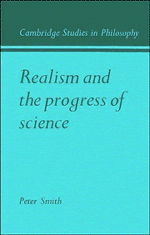1 - A realist account of scientific progress
Published online by Cambridge University Press: 07 October 2011
Summary
THE CHALLENGE OF RELATIVISM
During this century, positivist and falsificationist explanations of how scientific progress comes about have given rise to considerable debate. According to the former there are two ways in which a well-confirmed theory T, i.e., one which explains a large number of observed regularities and has led to many successful predictions, comes to be replaced. Firstly, we may extend T in order to predict new phenomena. This, said the positivists, necessitates either the introduction of new “correspondence rules” which define the “theoretical terms” of T, or the supplementing of the theoretical postulates and basic laws; in either case we obtain a closely related new theory T′. We can then test T′ against its predictions: if it proves incorrect we reject it although we are free to retain T; if it proves correct we accept T′ and we are then free to press on to T″″, etc. Once we have established a theory like T we can work from it and so increase our stock of scientific knowledge. An example of successful theory extension is the development of the theory of mechanics. Originally it was formulated to describe the motions of pointmasses, and was later extended to encompass the motions of rigid bodies.
The second, and more complex, way in which the positivists thought a well-confirmed theory comes to be replaced is when it is reduced to, or subsumed under, a second theory which was originally formulated in a different area.
- Type
- Chapter
- Information
- Realism and the Progress of Science , pp. 4 - 17Publisher: Cambridge University PressPrint publication year: 1981



